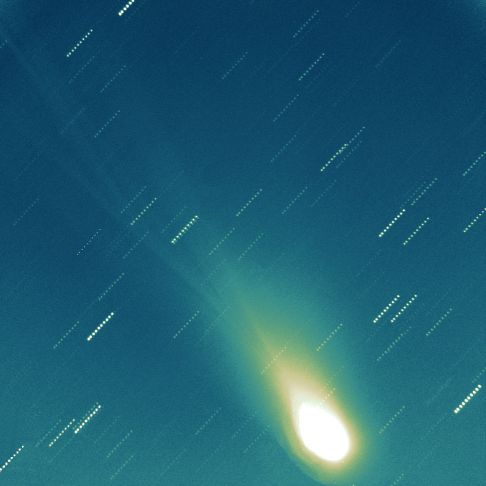
|
Credit & Copyright: Jure Skvarc,
Bojan Dintinjana,
Herman Mikuz
(Crni Vrh
Observatory, Slovenia)
Explanation:
Comet C/1999 S4 LINEAR is only one of
many
comets discovered with the
Lincoln Near Earth
Asteroid Research (LINEAR) telescope
operating near Soccoro, New Mexico, USA.
Traveling steadily southward through Earth's night sky, C/1999 S4
passed perihelion (closest approach to the Sun) yesterday on what is likely
its
first trip through the
inner
solar system.
Now fading,
comet LINEAR
became no brighter than about 6th
magnitude, but is still easily visible
with binoculars in northern hemisphere skies.
While the memorable comets
Hale-Bopp and
Hyakutake were much brighter,
comet LINEAR is
displaying
delightful tails evident in this false-color composite
image
from the
Crni Vrh
Observatory in Slovenia.
The combined series of exposures made on July 22nd are
registered on the comet.
In the resulting picture, stars appear as rows of dots,
but the faint structures in
the comet's tail are beautifully recorded.
Presently seen moving from
Ursa Major to Leo this
comet LINEAR will
begin to shine in southern hemisphere skies in August.
|
January February March April May June July August September October November December |
| |||||||||||||||||||||||||||||||||||||||||||||||||||||||
NASA Web Site Statements, Warnings, and Disclaimers
NASA Official: Jay Norris. Specific rights apply.
A service of: LHEA at NASA / GSFC
& Michigan Tech. U.
Based on Astronomy Picture
Of the Day
Publications with keywords: comet - comet linear - C/1999 S4 comet
Publications with words: comet - comet linear - C/1999 S4 comet
See also:
- APOD: 2025 February 5 Á Comet G3 ATLAS Setting over a Chilean Hill
- APOD: 2025 February 2 Á Comet G3 ATLAS Disintegrates
- APOD: 2025 January 28 Á Comet G3 ATLAS over Uruguay
- APOD: 2025 January 26 Á The Many Tails of Comet G3 ATLAS
- Comet G3 ATLAS: a Tail and a Telescope
- APOD: 2025 January 21 Á Comet ATLAS over Brasilia
- APOD: 2025 January 20 Á Comet ATLAS Rounds the Sun
